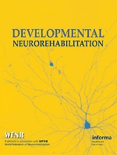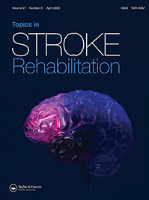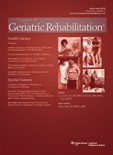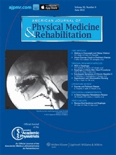
European Journal of Physical and Rehabilitation Medicine
Scope & Guideline
Innovating Patient Care: Your Gateway to Rehabilitation Insights
Introduction
Aims and Scopes
- Rehabilitation Interventions and Outcomes:
The journal publishes studies evaluating various rehabilitation interventions, including physical therapy, occupational therapy, and innovative techniques like robotic rehabilitation and virtual reality, emphasizing their effectiveness and impact on patient outcomes. - Chronic Conditions and Disabilities:
Research on the rehabilitation of patients with chronic diseases and disabilities, such as stroke, spinal cord injury, and neurodegenerative diseases, highlighting tailored rehabilitation approaches to enhance functional recovery and quality of life. - Evidence-Based Guidelines and Position Papers:
The journal frequently features evidence-based guidelines and position papers that outline best practices in rehabilitation medicine, ensuring practitioners have access to the latest research findings and recommendations. - Innovations in Rehabilitation Technology:
A core area of focus includes the exploration and validation of new technologies and methodologies in rehabilitation, such as telerehabilitation, wearable devices, and mobile health applications. - Psychosocial Factors in Rehabilitation:
Research addressing the psychosocial aspects of rehabilitation, including the role of mental health, caregiver involvement, and social determinants of health in recovery outcomes. - Functional Assessment and Measurement Tools:
The journal emphasizes the development and validation of assessment tools based on the International Classification of Functioning, Disability and Health (ICF) framework, promoting standardized measures of patient functioning and disability.
Trending and Emerging
- Tele-rehabilitation and Digital Health:
The increasing focus on tele-rehabilitation and digital health solutions has emerged as a significant trend, particularly in light of the COVID-19 pandemic. Studies exploring the effectiveness of remote rehabilitation interventions are gaining prominence. - Multidisciplinary and Holistic Approaches:
There is a growing emphasis on multidisciplinary approaches that incorporate various health professionals' expertise, recognizing the complex interplay of physical, psychological, and social factors in rehabilitation. - Neurorehabilitation Innovations:
Innovative techniques in neurorehabilitation, such as robotic-assisted therapy and neuromodulation methods, are trending, reflecting advancements in technology aimed at enhancing recovery for neurological patients. - Chronic Pain Management:
Research focusing on chronic pain management strategies within rehabilitation settings is on the rise, highlighting the need for effective interventions to address pain in diverse populations. - Patient-Centered Care and Shared Decision-Making:
Emerging themes emphasize the importance of patient-centered care models and shared decision-making in rehabilitation, aiming to enhance patient engagement and satisfaction with treatment. - Functional and Quality of Life Assessments:
There is an increasing interest in studies that assess functional outcomes and quality of life in rehabilitation, aligning with the shift towards measuring the effectiveness of rehabilitation interventions comprehensively.
Declining or Waning
- Traditional Rehabilitation Techniques:
There is a noticeable decline in publications focused solely on traditional rehabilitation techniques, such as manual therapies, as the field increasingly embraces evidence-based approaches and innovative technologies. - Pharmacological Interventions:
Research concerning pharmacological interventions in rehabilitation is decreasing, as there is a stronger emphasis on non-pharmacological approaches, including exercise-based therapies and lifestyle modifications. - Generalized Rehabilitation Approaches:
Papers discussing generalized or non-specific rehabilitation strategies are becoming less common, with a shift toward more targeted, individualized rehabilitation protocols tailored to specific patient populations. - Reactive Rehabilitation Models:
There is a waning interest in reactive models of rehabilitation that focus solely on post-injury or post-surgical care, as preventive and proactive rehabilitation strategies gain traction.
Similar Journals

PHYSIKALISCHE MEDIZIN REHABILITATIONSMEDIZIN KURORTMEDIZIN
Exploring New Frontiers in Physical Medicine and RehabilitationPHYSIKALISCHE MEDIZIN REHABILITATIONSMEDIZIN KURORTMEDIZIN, published by GEORG THIEME VERLAG KG, is a prominent journal dedicated to the fields of physical medicine, rehabilitation, and resort medicine. With its ISSN of 0940-6689 and E-ISSN 1439-085X, this journal has been at the forefront of disseminating essential research and innovative practices since its inception. Operating from Germany, it offers a crucial platform for professionals, researchers, and students engaged in exploring the latest advancements in rehabilitation methodologies and therapeutic practices. Although it currently holds a Q4 ranking in several categories including Physical Therapy and Rehabilitation, the journal is committed to enhancing its impact and visibility within the academic community. The journal publishes research, reviews, and clinical studies aimed at improving patient outcomes and advancing the science of rehabilitation. Subscribers can expect high-quality content that addresses both theoretical and practical aspects of rehabilitation medicine, ultimately contributing significantly to ongoing discussions and developments in the field.

Developmental Neurorehabilitation
Fostering interdisciplinary dialogue in developmental care.Developmental Neurorehabilitation is an esteemed journal published by Taylor & Francis Inc, dedicated to advancing the field of developmental neuroscience and rehabilitation. With an ISSN of 1751-8423 and an E-ISSN of 1751-8431, this journal serves as a vital resource for researchers, clinicians, and students interested in innovative therapeutic approaches and rehabilitation techniques for children and adolescents. Since its inception in 1997, Developmental Neurorehabilitation has focused on disseminating high-quality research, contributing to a deeper understanding of recovery processes in developmental disorders, and facilitating interdisciplinary dialogue among professionals. With its recognition in Q2 and Q3 quartiles across prominent categories such as Pediatrics and Rehabilitation, it stands out as a pivotal publication in its field, boasting Scopus rankings that reflect its significant impact—ranked #53 in Rehabilitation and #139 in Pediatrics, among others. While maintaining a commitment to quality research, the journal does not currently offer open access but remains accessible through institutional subscriptions, further enriching the academic landscape with critical insights into rehabilitation methodologies for developmental challenges and promoting better clinical practices to improve patient outcomes.

International Journal of Sports Physical Therapy
Empowering rehabilitation with innovative insights.Welcome to the International Journal of Sports Physical Therapy, a premier platform dedicated to advancing the field of sports therapy and rehabilitation. Published by the NORTH AMER SPORTS MEDICINE INST-NASMI, this open access journal has been vital in disseminating state-of-the-art research since its inception in 2011. With an ISSN of 2159-2896, it boasts a commendable standing within the academic community, achieving a Q2 ranking in 2023 across multiple categories, including Orthopedics and Sports Medicine, Physical Therapy, and Rehabilitation. Spanning diverse topics relevant to sports physical therapy, this journal serves as an invaluable resource for researchers, clinicians, and students alike, promoting best practices and innovative techniques in the field. By maintaining a commitment to high-quality peer-reviewed content, it not only contributes significantly to the existing body of knowledge but also fosters collaboration among professionals seeking to enhance patient care and rehabilitation outcomes.

Topics in Stroke Rehabilitation
Transforming care for stroke survivors.Topics in Stroke Rehabilitation, published by Taylor & Francis Ltd, stands as a premier academic journal offering cutting-edge research and insights in the fields of rehabilitation, neurology, and community care. With an impressive impact factor reflecting its strong scholarly influence, this journal not only maintains a distinguished Q1 ranking in Community and Home Care and Rehabilitation but is also recognized in the Q2 category for Clinical Neurology, showcasing its relevance across multiple disciplines. Covering a comprehensive range of topics from neurorehabilitation techniques to patient-centered care strategies, Topics in Stroke Rehabilitation serves as an essential resource for researchers, healthcare professionals, and students dedicated to enhancing the quality of life for individuals recovering from stroke. With an accessible archive dating back to 1996 and continuous publication through 2024, this journal invites collaboration and discourse, fostering advancements in both theoretical knowledge and practical applications within the realm of stroke rehabilitation.

Turkish Journal of Physiotherapy Rehabilitation-Turk Fizyoterapi ve Rehabilitasyon Dergisi
Transforming lives through evidence-based rehabilitation.The Turkish Journal of Physiotherapy Rehabilitation (Turk Fizyoterapi ve Rehabilitasyon Dergisi), published by the TURKEY ASSOC PHYSIOTHERAPISTS, stands as a significant platform for the dissemination of research and developments in the fields of physiotherapy, rehabilitation, orthopedics, and sports medicine. Since its inception in 2018, the journal has been dedicated to advancing the understanding and practice of rehabilitation therapies, contributing valuable insights to both clinicians and researchers alike. Currently classified in the Q4 category across various relevant fields, including Orthopedics, Sports Medicine, and Physical Therapy, it reflects the evolving landscape of rehabilitation science. Although the journal is indexed in Scopus with ranks indicating its nascent stage, it serves as an essential resource for the academic community in Turkey and beyond. Researchers and professionals interested in innovative rehabilitation practices and advancements are encouraged to utilize this open access journal to share knowledge, fostering collaboration and growth within this critical area of healthcare.

Balneo and PRM Research Journal
Advancing knowledge in physical therapy and rehabilitation.Balneo and PRM Research Journal, an esteemed publication of the Romanian Association of Balneology, serves as a valuable forum for the dissemination of innovative research in the fields of physical therapy, sports therapy, rehabilitation, and the medical management of rheumatic conditions. With its commitment to Open Access principles since 2011, the journal ensures that groundbreaking findings are accessible to a global audience, promoting collaboration and advancing knowledge within the academic community. Despite its emerging status, as reflected in its Scopus rankings—with Physical Therapy, Sports Therapy and Rehabilitation ranked at the 25th percentile, and Rheumatology at the 21st percentile—the journal is positioned to make significant contributions to clinical practice and research. The journal is published in the heart of Romania, at Bucharest, and operates from 2021 to 2024, focusing on the intersection of balneotherapy and modern rehabilitation techniques. As a crucial resource for researchers, professionals, and students alike, Balneo and PRM Research Journal invites submissions that explore the latest advancements and clinical applications in these vital areas of health sciences.

Current Physical Medicine and Rehabilitation Reports
Empowering Professionals Through Cutting-Edge ResearchCurrent Physical Medicine and Rehabilitation Reports, published by SpringerNature, is an esteemed academic journal dedicated to advancing the fields of physical medicine and rehabilitation. With a focus on disseminating high-quality research and evidence-based practices, this journal covers a broad spectrum of topics including orthopedic medicine, sports therapy, and comprehensive rehabilitation strategies. While it currently holds a Q3 quartile ranking across several related categories, including medicine and rehabilitation, the journal aims to elevate its impact through open access to its content, fostering a global discussion amongst researchers, professionals, and students alike. Navigating the intersections of innovation and clinical application, Current Physical Medicine and Rehabilitation Reports serves as a vital resource for those seeking to enhance their understanding and practice in this dynamic field. With its evolving scope, the journal is committed to publishing studies and reviews that shape the future of rehabilitation and physical medicine practices.

Annals of Rehabilitation Medicine-ARM
Exploring New Frontiers in Rehabilitation MedicineAnnals of Rehabilitation Medicine (ARM), published by the Korean Academy of Rehabilitation Medicine, is a distinguished open-access journal dedicated to advancing the field of rehabilitation medicine since its inception in 1977. With its E-ISSN 2234-0653, ARM aims to disseminate high-quality, peer-reviewed research that reflects both the breadth and depth of rehabilitation practices. As of 2023, the journal ranks in the Q2 quartile within the Rehabilitation category, placing it among the top half of journals in this domain, and it holds a respectable position in the Scopus rankings, being 70th out of 161 in the discipline. This journal emphasizes the importance of innovative research and clinical practices that improve patient outcomes in rehabilitation settings. Researchers, clinicians, and students alike will find valuable insights and the latest developments in rehabilitation science, enhancing their understanding and practice through its accessible content.

TOPICS IN GERIATRIC REHABILITATION
Shaping the Future of Elderly Care Through KnowledgeTopics in Geriatric Rehabilitation is a premier scholarly journal dedicated to advancing the field of geriatric rehabilitation, published by Lippincott Williams & Wilkins. With the ISSN 0882-7524 and an E-ISSN of 1550-2414, the journal has been a vital resource since its inception in 1985, providing a platform for innovative research and clinical studies that address the rehabilitation needs of older adults. It features a diverse range of articles that contribute significantly to the understanding of geriatric care practices, physical therapy, and rehabilitation strategies. Although currently categorized as Q4 in Geriatrics and Gerontology and Q3 in both Physical Therapy, Sports Therapy, and Rehabilitation, and general Rehabilitation, the journal continually strives to improve its scholarly impact and visibility within the medical community. The journal's eclectic content is invaluable for researchers, clinicians, and students alike, aiming to foster a better understanding of geriatric rehabilitation and improve health outcomes for older populations. With plans for expansion in open access options and a commitment to high-quality peer-reviewed content, Topics in Geriatric Rehabilitation remains dedicated to supporting advancements in this crucial field.

AMERICAN JOURNAL OF PHYSICAL MEDICINE & REHABILITATION
Innovating Physical Medicine for a Healthier TomorrowAmerican Journal of Physical Medicine & Rehabilitation, published by Lippincott Williams & Wilkins, is a leading journal in the field of rehabilitation, dedicated to advancing knowledge in physical medicine and rehabilitation practices. With an established history from 1988 to 2024, this journal serves as a vital resource for clinicians, researchers, and students interested in the multifaceted aspects of rehabilitation science. It holds a commendable Q2 ranking in the Physical Therapy and Sports Therapy fields and a prestigious Q1 position in Rehabilitation, reflecting its impact and relevance in the academic community. The journal's Scopus rankings further highlight its significance, placing it among the top percentile for both rehabilitation medicine and physical therapy. Although it does not currently offer open access options, its accessibility through institutional subscriptions ensures widespread reach. By publishing high-quality research, clinical studies, and reviews, the American Journal of Physical Medicine & Rehabilitation plays a critical role in shaping contemporary rehabilitation practices and improving patient outcomes.